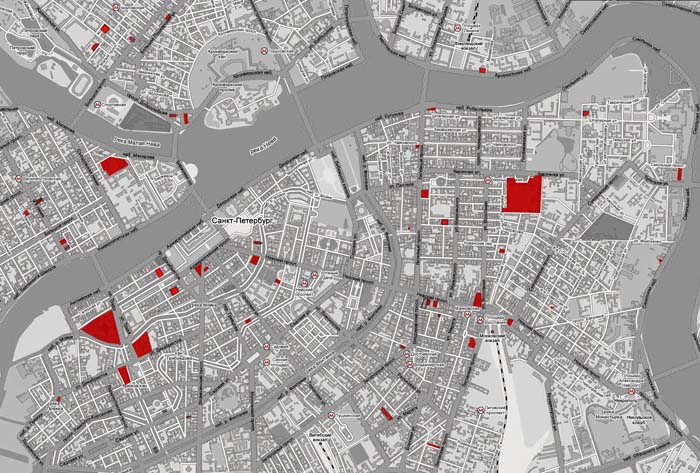
Factual basis
In last 5 years the city of Saint Petersburg lost more than 100 historical buildings. These houses were built in 18 and 19 centuries, many of them were considered architectural monuments. Now they are pronounced obsolete and untenable and raised to be substituted with shopping malls, hotels and business centers. In some cases the original facade is left while the rest is rebuilt completely anew. These facts are thoroughly documented by a number of independent researchers.
These events were an initial cause for my research. At first place my personal concern is not of a historical or a social nature but rather a phenomenological inquiry: how a man experiences these absences in the city’s tissue? Why does it appear to be a wound, an irreversible loss?
An old house is always more than a mere structure — a complex conglomeration of histories, thoughts, fluids, letters, debris… What happens when it dies?

Mythic dimension
The procedures which the building undergoes before demolition bear a great resemblance to the funeral rites in ancient cultures (e.g. scraping of innards, wrapping body in a cloak, etc.).
The city of Saint Petersburg is located in a delta of the Neva River flowing north-west and falling into the ocean. In various beliefs (e.g. of Finno-Ugric people, primeval inhabitants of this places) it would be a way to the underworld. What’s more one can see a striking resemblance when superposing the plan of Petersburg upon the map of Hellenistic realms of Hades. City channels perfectly match 4 rivers of the Greek underworld. There are a significant amount of cultural references to the city’s boundary nature in Russian literature.
My objective is to trace the journey of the “dead” through the underworld, to map this space beyond that mirrors (and consumes) the “real” city.
At the exhibition the viewer participates in a kind of Orphic mystery following the deceased and gaining knowledge and purification. The visitor is faced and questioned with this inquiring absence. He or she beholds the Altar of 100 Deceased, which are represented with 100 masks (mask, a mysterious object with only one surface, a device used to embody the absent since late Stone Age). The viewer becomes the one who is been viewed.

Deciphering landscape
The practical purpose of my research is to put into fine art context and bring to public attention present-day issues concerning these irreversible processes (which surely happen in many places).
The theoretical interest is to develop the methods of reading mute strata, collective sediments and unpronounced reality of e.g. urban landscape with the help of ‘mythopoetical’ practices: intuitive insight, creative reflection. The ontological status of human settlement might be examined and emphasized with the help of history of world beliefs.
The project should result in an exhibition which consist of two parts, upper and lower:
– Evidence and analysis.
Study of a real city’s body altered, traumatized space and resident’s reaction to these interferences.
The gallery of lacunas, demolished buildings with detailed information on their origin, history and passing.
Map of the clearance sites with structural typology.
– Myth and synthesis.
The inverted "upper" city. Here incarnate those, who had passed above.
Schemes, maps, anatomic studies of the “dead”, their portraits and biographies, personal belongings, memories and thoughts, videos of their posthumous journeys and visions. Meditation on phenomenology of being a house.
The exhibition may happen not solely in the gallery place but as a happening or an interference in everyday public spaces as well.
Art-theory aspect.
In general the project is conceptual in its core. There is no purpose to bring valuable 'artworks' in the gallery, but rather to bring the viewer outside (and beyond). The real 'art', anonymous 'land-artworks of demolition' take place out in the city. Here we are left with references and mere traces, which rapidly decay into oblivion themselves.
beautiful dead page on my web-site



No comments:
Post a Comment